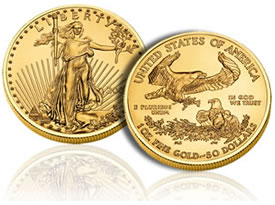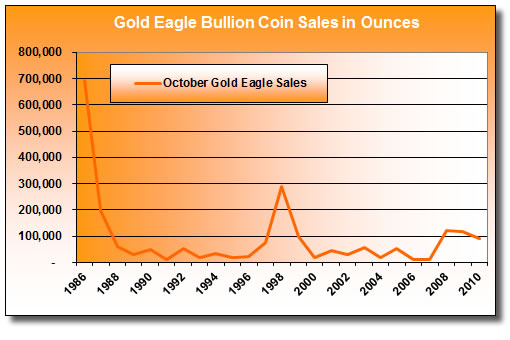Here is a look at one of the best articles regarding the history of gold value that may provide insightful looks at future investments. This article is long but to good to hack apart. With the economy in poor shape looking at the history of golds value and the economy is worthy reading.
Fundamentals Revisited
By Barry Forst
Since recent action in the gold market has been quite volatile, I think it's important to refocus on the long term fundamentals. Many times, investors are sidetracked by dramatic price swings, reacting emotionally with either greed or fear. During the current decline we recommend that clients add to their hedge positions. The bull market is still intact and that the "fundamentals for gold" are stronger than ever.
Perspective: Gold is a commodity that has functioned throughout history as a "store of value", a refuge from depreciating money of all types. For more than 5,000 years, citizens have learned and the history of the value of gold has proven(sometimes the hard way) .
Remember This: there has never been a paper currency that has not been depreciated to the point of being virtually worthless; only gold has remained a viable store of value. And this will most likely be the future of golds value.
The beginning: The first step to converting the dollar into fiat currency was the creation of the federal reserve system in 1914. The FED was given absolute power to issue notes and create credit for its own profit without accounting to congress or the general accounting office. The FED was patterned after European central banks. Specifically, the German Reichsbank.
Until 1934, the gold standard acted as a restraint on the FED, preventing serious monetary expansion. But in 1934 Roosevelt confiscated U.S gold coins. That left the citizens holding $20 dollars in paper money for every once of gold. He then raised the gold value by 67 % to $35 an ounce, enabling the government to receive the profit that resulted. With domestic convertibility no longer a restraint, only international conversion prevented unlimited monetary expansion. In 1971 however, Nixon removed this final barrier when he "closed the gold window" as part of his anti-inflation program. The resulting currency depreciation is now part of our, unfortunate financial history.
The FED functions today as a governmental body that issues fiat money and influences the level of consumer credit through the manipulation of bank reserves. The FED, therefore, creates "elasticity" which allows our government the flexibility of printing worthless pieces of paper to cover its own debt obligations. In the absence of any restraint, our government continues to depreciate the dollar. We need to get gold back into the monetary system. But our current FED chairman, Paul Volcker, is strongly opposed to any monetary role for gold. We strongly disagree with Mr. Volcker and think that John Exter ( Formally of New York City and Bank and the Federal Reserve System) has a much better grasp of the current situation. See if you don't agree with Exter: (remember this section of the history of the value of gold was written in 1980)
"Paper money expansionism will not work, but even highly sophisticated monetary authorities go on for years accepting evermore worthless paper instead of demanding gold. But the time has come at last when people, including even foreign central bankers, no longer want to hold more and more and evermore worthless currencies. Confidence in a currency can erode rapidly once it becomes inconvertible, for only convertibility enables it to maintain its store of value function indefinitely. Without convertibility, history shows that a currency will ultimately become worthless and disappear."(this is the future and the value of gold is rising)This discussion of the FED and the government's attempt to expand money and credit leads us logically to the discussion of inflation. Inflation is a monetary phenomenon. Prices rise whenever th quantity of money is increased rapidly in ralation to real productive output. Between 1971 and 1976, the output of goods and services rose by 18%. But during the same period there was a 78% increase in the money supply and a 50% increase in consumer prices. This article is part one of a series about the history regarding the value of gold. This is one of the best for factual historic events and content.
The real course of inflation is printing too much money, and the only source of printing that money is the Federal Government. They have formed a monopoly -- the Federal Reserve Board -- and they alone have the power to manipulate, govern and otherwise determine the total supply of checkbook dollars issued by the banking system. Therefore, the government has complete control over the amount of money in circulation, and because of its desire to benefit certain interest groups, the FED keeps pumping new money into the economy. More articles about the history of golds value and gold mining visit Gold Mining California. The future of golds value could already be history.
Inflation affects everybody, but its negative effects do not fall on people in proportion to their income or wealth, or in any other way that could be considered equitable. Inflation hurts creditors (those who loan money) while it benefits debtors (people who've borrowed money). It benefits debtors because they're able to repay creditors in dollars that are worth less than the dollars they originally borrowed. The biggest creditors are people on fixed incomes, those on pensions, social security and the like. In a sense, they loaned money to their employers, unions or government at the time they paid into the programs, hoping, of course, to be paid back with profit from interest that would accumulate up to their retirement. But inflation has destroyed those hopes. For example, at 7% inflation, a retired person would see his $500-a month payment decline in purchasing power to $250 in just ten years... at 10% inflation only $175 in purchasing power would remain after ten years. While again the history of the value of gold holds strong despite and maybe because of the follies of the federal government.
Debtors benefit from inflation, and the government is the biggest single debtor. Currently, the deficit is running at more than 1 billion dollars a week and the accumulation debt siphons off an additional $1 billion in interest payment. In addition to the benefit of paying off its debt in "cheaper" dollars, the government benefits from inflation due to the graduated income tax which constantly pushes people into higher tax brackets even though there has been no real increase in their income. (The whole time this is happening the history of the value of gold has shown golds price to rise as the dollar dwindles. One of the reasons being that people know gold is something that will withstand the hardships of the paper moneys slow demise)
The government will continue to increase the money supply so long as the public continues to demand: more jobs, increased welfare payments, a national health plan, farm subsidies and other "free" services and programs. We have a situation in which more and more new programs are created, and the old programs continue to expand beyond all reason. The problem is that the cost of these programs exceeds current Federal tax receipts, and thus Congress asks the Treasury to issue debt instruments so they don't have to raise taxes. The debt instruments are then floated to the public in the form of Treasury bonds and bills, which are then bought by private citizens, institutions, foreign governments and OPEC countries. If there remain unpurchased bonds, the FED will print new money in that amount.
It is with the above process that the government creates inflation. They do it because it is politically expedient to do so. Congress can win the support of special interests by funding their programs without having to increase taxes.
To date there has been no major change either in Congress or the vast bureaucracy which suggests an end to irresponsible government spending, so it appears that inflation will continue to be a problem for quite some time. And as has always been in Case throughout history, citizens will continue to employ gold to protect their assets from inflation and monetary turmoil. Almost every monetary crisis, military conflict, or OPEC price increase triggers new price rises in gold, as the demand for a reliable, portable store of value grows.
When compared to basic goods and services, gold has maintained its value. If one compares the price of gold with actual of clothing, rent, food, etc., during various periods in the 20th century, one discovers that ... in relation to gold . . . prices of these items have remained virtually constant. What has actually happened is the the dollar has decreased in value, thus it requires more dollars (higher prices) to buy the same amount of goods and services.
When the depreciation of any currency reaches the point where the citizens begin to reject it, the government tries to force acceptance through the use of legal tender laws. But the only "law" that ends up working is Gresham's Law; bad money drives out good (good money hoarded -- Ed.) What's meant by this is that, when real money and legal tender circulate in the economy side by side, people will always choose the greater value, in this case gold and silver.
Why do people always choose "real money"? Gold is more rare than paper money and cannot be generated as can paper. Gold is more durable than paper. It's divisible into various and convenient size units and is therefore extremely easy to exchange. Gold also has a relatively high unit value; a half-million dollars will fit easily into a standard safety deposit box. For these very good reasons, gold has evolved into a universally desirable medium of exchange that inspires confidence throughout the world because it is beyond any government's whim. Gold provides citizens with monetary independence, with freedom from the destructive effects of government caused currency debasement.













































 Marriage is a poise relationship and union of two souls who promise to care for each other for whole life. They share their problems, grief, joys and make promise to support each other in each and every condition. The bride and groom pay a lot of attention on their appearance on this special day. The bride wears stylish clothes and jewellery items such as earrings, bracelets, rings, jhumer, and necklaces etc.
Marriage is a poise relationship and union of two souls who promise to care for each other for whole life. They share their problems, grief, joys and make promise to support each other in each and every condition. The bride and groom pay a lot of attention on their appearance on this special day. The bride wears stylish clothes and jewellery items such as earrings, bracelets, rings, jhumer, and necklaces etc. In the world of jewellery manufacturing Titanium is a new style and look of jewellery and it has got good response. Other then this valuable and fashionable pearls and gems such as diamonds, emeralds, rubies and sapphires are also used in the manufacturing of rings, earrings, bracelets, rings and necklaces. Some brides want bridal jewellery with diamonds and other valuable and beautiful gemstones. Bridal jewellery makes the bride unique and different and gives him a unique look from everybody else. There are several designers and manufacturers that create beautiful and attractive jewellery items.
In the world of jewellery manufacturing Titanium is a new style and look of jewellery and it has got good response. Other then this valuable and fashionable pearls and gems such as diamonds, emeralds, rubies and sapphires are also used in the manufacturing of rings, earrings, bracelets, rings and necklaces. Some brides want bridal jewellery with diamonds and other valuable and beautiful gemstones. Bridal jewellery makes the bride unique and different and gives him a unique look from everybody else. There are several designers and manufacturers that create beautiful and attractive jewellery items. The market has various kinds of jewellery but the most popular jewellery, such as Anita, Cassandra and Desiree. Anita is made of Swarovski crystals and silver, Cassandra is made of freshwater pearls and Desiree is also prepared with the same material. Earrings are most important and prominent part of bridal jewellery and the names of some new jewellery items are Celine, Jenifer and Maria.
The market has various kinds of jewellery but the most popular jewellery, such as Anita, Cassandra and Desiree. Anita is made of Swarovski crystals and silver, Cassandra is made of freshwater pearls and Desiree is also prepared with the same material. Earrings are most important and prominent part of bridal jewellery and the names of some new jewellery items are Celine, Jenifer and Maria. Bridal jewellery is important to make your look unique and great on this important occasion. In the process of selection of appropriate jewellery, it is necessary to look for colors and beautiful designs which would give you a different and stylish look. They should match and increase the dress beauty of the bride to give a charming look. A large number of jewellery stores are available online or offline to sell their unique, latest and stylish products. Necklaces, earrings, rings, bangles and bracelets give traditional and attractive look to the bride with new style.
Bridal jewellery is important to make your look unique and great on this important occasion. In the process of selection of appropriate jewellery, it is necessary to look for colors and beautiful designs which would give you a different and stylish look. They should match and increase the dress beauty of the bride to give a charming look. A large number of jewellery stores are available online or offline to sell their unique, latest and stylish products. Necklaces, earrings, rings, bangles and bracelets give traditional and attractive look to the bride with new style.










